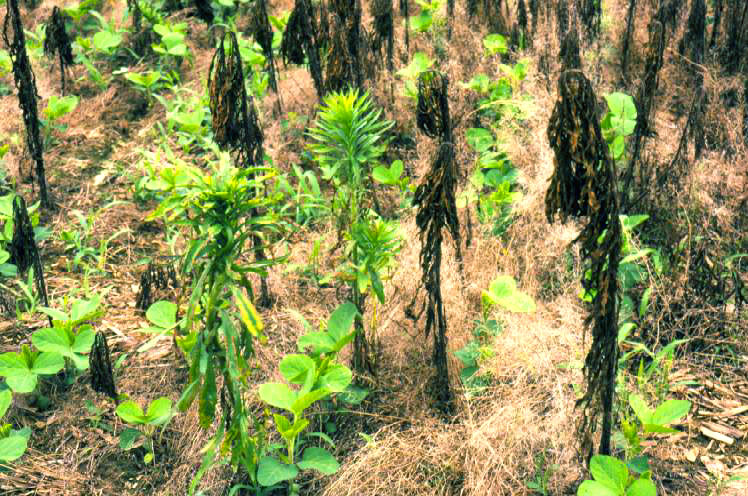This website was created for Biology 361: Genetically Modified Organisms at Davidson College.by Mike Chase and Monica Siegenthaler
| Background |
|||||||||||
|
Permission pending from http://www.rec.udel.edu/weed_sci/WeedFacts/Marestail-resistance.htm |
Interesting Facts: - Herbicides are the most widely used class of pesticides in the world accounting for 44% of all sales in 1988 (Conko, 2002). - Weeds are estimated to cause more than $40 billion in annual global agricultural losses (Conko, 2002). |
||||||||||
| History of
Herbicides
Herbicides and pest control have been around for hundreds of
years. The first documented uses of herbicides occurred about 200 years
ago, but even before that natural processes of genetic selection by
farmers provided some resistant to weeds. The 1st commercial
selective broadleaf weed herbicides
(2.4-D and MCPA) came onto the market in 1945 and 1946 respectively.
Reasoning behind the emergence of the herbicides at that time included
wartime resource allocation (Liebman, 1993). During the war, resources
were concentrated on supplies needed directly for the armed services
and agriculture lost a great deal of support. Therefore, new ways of
producing the same yield had to be established. Herbicides have experienced a great industrial growth up through the 1970ís. In the 1970ís herbicides experienced a growth of 6.3%, in the 80ís 2.2%, and in the 90ís 0.1%. The slow decline of production of new herbicides was due in part to the identification of new active agents in the chemical make-up of the herbicides (Tilman, 2002).
Permissiong pending from http://www/agronomyday.cropsci.uiuc.edu/ 2001/tours/roundup-ready/
Classifying Herbicides
Numerous systems have emerged to classify both herbicides and
pesticides. Many classifications divide each substance by its biological
means of attacking the desired weed or insect responsible for the deterioration
of the chosen organism (Gunsolus, 1999). The overall route in which
herbicides affect the cellular biology of a plant is called the Mode-of-Action. In a summery written by
Merill A. Ross, professor of Weed Science, and Daniel K. Childs, an
Extension Weed Specialist, in the Department of botany and Plant Pathology
at Purdue University organize herbicides into two different groups by
the manner in which they are applied to the plant. An herbicide can
either be applied to the foliage or directly to the surrounding soil
(Herbicide Handbook, 1994).
Examples of foliage-applied herbicides include: Auxin Growth
Regulators, Amino Acid Inhibitors, and Chlorophyll/ Carotenoid Inhibitors.
Examples of soil-applied herbicides include: Root Inhibitors and Shoot
Inhibitors (Ross, 2001). To see all the classifications of herbicides
and their chemical and common names go to The
Department of Botany at Purdue University website. |
|||||||||||
 |
 |
© Copyright 2002 Department of Biology, Davidson College,
Davidson, NC 28035
Send comments, questions, and suggestions to: michase@davidson.edu
or mosiegenthaler@davidson.edu


 SDS occurring
in Soybeans
SDS occurring
in Soybeans